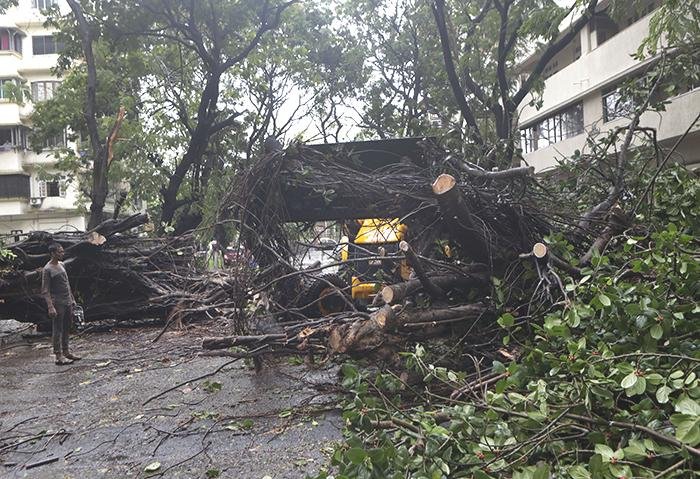MUMBAI, India -- The first cyclone in more than a century to hit India's financial capital, Mumbai, appeared to have largely spared the metropolis on Wednesday.
No deaths or major damage was reported as workers began clearing fallen trees and other debris from affected areas along India's western coastline.
As Cyclone Nisarga crossed the central state of Maharashtra, live TV coverage showed black clouds framing the Arabian Sea, and trees swaying as rain pounded coastal towns and villages.
In the state capital, Mumbai, home to Bollywood, India's largest stock exchange and more than 18 million residents, high winds whipped skyscrapers and ripped apart shanties near the beach.
[Gallery not loading above? Click here for more photos » arkansasonline.com/64india/]
About 10,000 city residents were evacuated from their homes, municipal officials said. With powerful storms a rarity, there were no preexisting cyclone shelters, and many of the city's large and sturdy buildings have already been converted into coronavirus isolation or treatment facilities, National Disaster Response Force spokesman Krishan Kumar said.
"We moved people to other strong buildings where there is a supply of water," he said.
In the hours before the storm hit India's shores, drivers and peddlers deserted Mumbai's iconic Marine Drive, fishermen yanked their nets out of the wavy Arabian Sea and police shooed people away from beaches.
Homes in city slums were boarded up and abandoned, and officials patrolled the streets, using bullhorns to order people to stay inside.
Nisarga delivered heavy rain and sustained winds of 62 to 68 mph through Wednesday afternoon after slamming ashore near the city of Alibag, about 60 miles south of Mumbai, the Meteorological Department said.
In Alibag, photos posted on Twitter by the disaster agency showed toppled carts, fallen trees scattered over roads and tin roofs ripped apart.
Alibag absorbed some of the storm's power, reducing its impact on Mumbai, said Madhavan Rajeevan, secretary at the Ministry of Earth Sciences.
The storm moved away from the city across Maharashtra state with its wind speed slowing to 52 mph.
Ahead of the storm, about 100,000 people were evacuated from low-lying areas in Maharashtra and neighboring Gujarat. Both states, already among the hardest hit by the coronavirus pandemic, activated disaster response teams, fearing extensive flooding could further impair overwhelmed health systems.
About 200 covid-19 patients in Mumbai were moved from a field hospital beneath a tent to another facility to avoid the risk of strong winds, officials said.
Nisarga blew in just two weeks after Cyclone Amphan tore through the Bay of Bengal on India's east coast and battered West Bengal state, killing more than 100 people in India and neighboring Bangladesh.
The frequency of cyclones in the Arabian Sea is predicted to increase, said Adam Sobel, a climate scientist at Columbia University.
The temperature of the top layer of the sea, from which the cyclone draws its energy, is "unusually high," said K.J. Ramesh, former chief of India's Meteorological Department. Much more frequent and intense cyclones have been appearing over a shorter time in recent years due to climate change, he said.
"Forecasting such storms becomes a challenge," he said.
Information for this article was contributed by Chonchui Ngashangva of The Associated Press.
A Section on 06/04/2020
